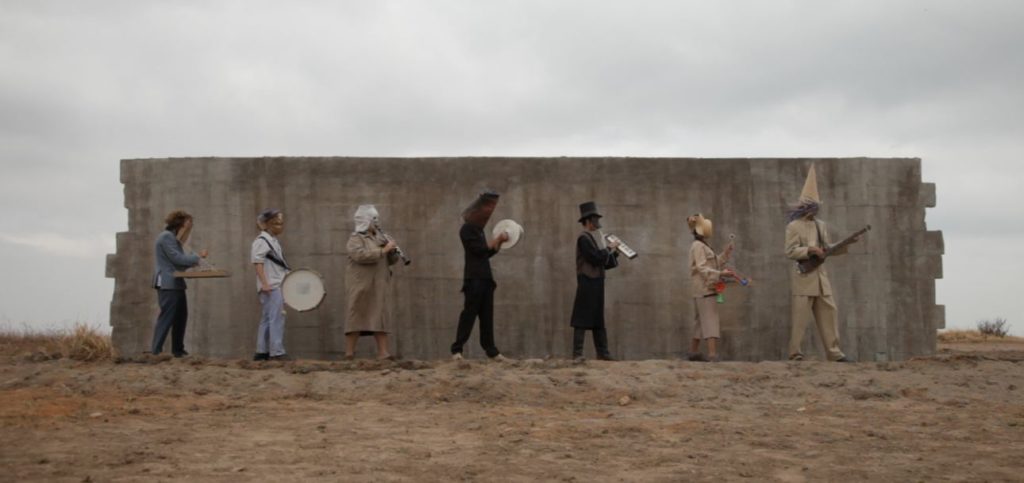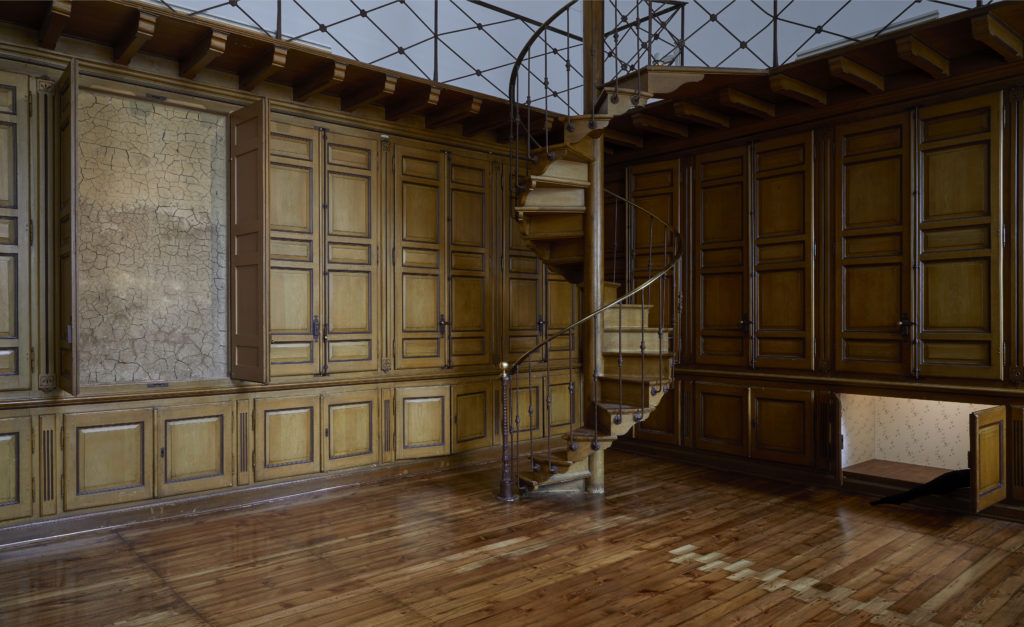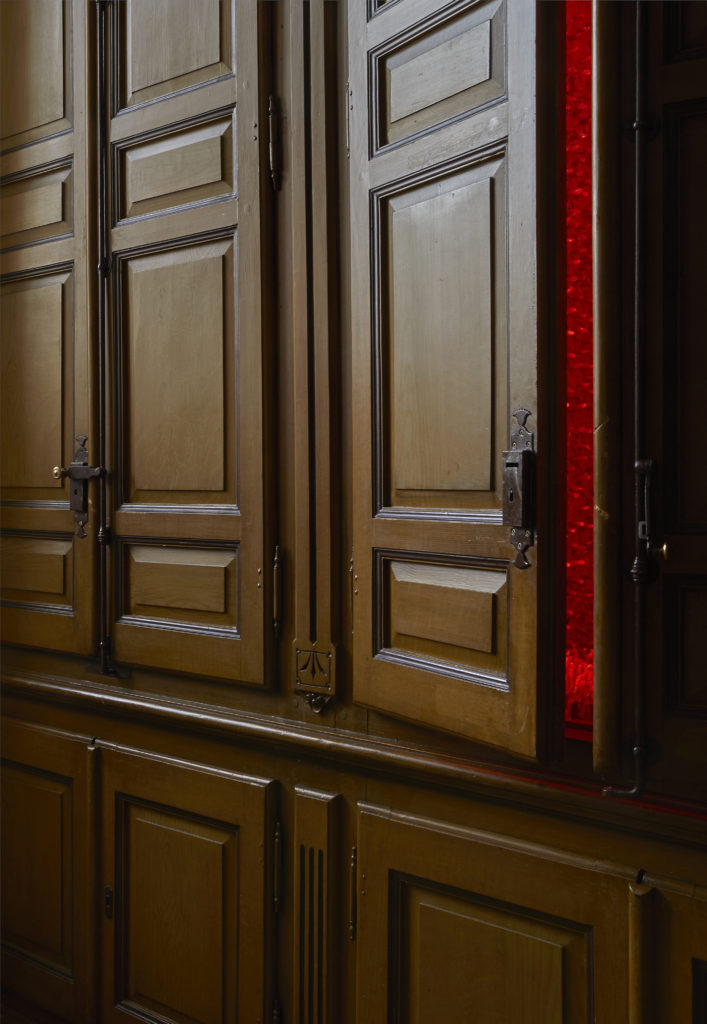All the World is a Stage: Sara Ramo // Profile of the Artist
by Ionit Behar

Spanish-born, Brazil-based artist Sara Ramo appropriates everyday elements and scenes, displacing them from their original context and rearranging them across her videos, photographs, collages, sculptures, and installations. The following conversation took place during the last weeks of her installation, lindalocaviejabruja, at The Museo Nacional Centrode Arte Reina Sof.a in Madrid. Ramo and I spoke of her recent works concerning feminist ideas, her passion for theater, and the current political situation in Brazil.
Ionit Behar: You are currently installing your upcoming show at the Reina Sofia—tell me a bit about the exhibition. I am curious about the title choice, lindalocaviejabruja or in English, beautifulcrazyoldwitch. What will you be showing there? What does the title refer to? And what was your process like for working on this project?
Sara Ramo: Absolutely—in this project, I used the museum as a studio, meaning I recorded the videos within the site, and made the installations inside the museum itself. It is an exhibition that relates to the space, but is also very open to the unconscious; I explored certain convictions about women and the feminine. In the end, I think the exhibition is a sort of fragmented story, or a fragmentation of bodies. This is something I have thought about in previous works as well, yet what is different here is that this museum has a very big emotional load for me—it was the first place in which I had contact with art, where I took refuge, where I went to the library. A place that made me feel welcome. This museum is not neutral for me—it is a place where, in a way, I found myself and left my condition of being a woman.
When I was thinking about lindalocaviejabruja , I imagined a sort of route or path that ran through all of the stigmas women face. For me, it was a difficult process, as I had to go through the work of understanding all the stigmas inside lindalocaviejabruja itself. I spent a whole year reading feminist books and texts, and although it was something that I had already done, this time I really submerged myself in the subject. It was like I started to see the world from another perspective, and it revealed a very painful reality.
IB: What books and texts have you been reading?
SR: I really liked the El Calibán y la Bruja (Caliban and the Witch: Women, the Body and Primitive Accumulation) (2004) by Silvia Federici and also Brujas (Witches) by Mona Cholette (2019). I reread Virginia Woolf’s A Room of One’s Own (1929) and Simone de Beauvoir’s The Second Sex (1949), both of which I had read when I was very young. I have also been reading Quem tem medo do feminismo negro? (2018) by Djamila Ta.s Ribeiro dos Santos, who writes on Black feminism in Brazil. It was a process of study that I did to survive, to sort of understand the things that happened and have happened to me.
IB: When you say ‘fragmented bodies,’ what are you referring to?
SR: For example, I am using one of the rooms in the museum—generally used for meetings—that is packed with closets and cabinets, where the audience can walk into. At first glance, it appears there is not much to see but then one can find strange and hidden things inside the closets.
There is also one video that shows a theater stage where the curtain covers the upper body of a woman and only her legs are visible. In another room there is a wallpaper with images of arms, legs, feet, and other body fragments. It is hard to explain because the idea of the fragments is more conceptual than illustrative. For example, the interior of one of the closets looks like the interior of a mouth or a vagina. There is a feminine presence being uncovered in the exhibition at different times that is sort of monstrous and unknown. Nothing is completely revealed, but rather everything is fragmented. I believe we, women, have not had the right space to express ourselves. So, in the show I make a non-existent woman made of fragments. The exhibition is a sort of sublimation from woman-object to woman-monster.

IB: Can you tell me about your installation Para Marcela e as Outras [For Marcela and the Others] at the Capela do Morumbi in San Pablo in 2017?
SR: They call this place a “chapel” but it is not really a chapel. It was a place where slaves lived and is now used for contemporary art exhibitions. You can see the construction technique of that time throughout the space—where walls were made with excrement, animal drool, blood, bugs, straw, earthworms, snails, etc. The walls were made in layers and held together with sticks that would eventually be taken out, leaving small holes in the walled foundation. This construction system is very common in Brazil, but in this Chapel, the walls were left unfinished and you are able to see the holes on the walls without the white cover. When I was invited to have a show here, I thought about this space as a body. The holes reminded me of death.
The neighborhood where I live is home to many transwomen who do sex work, and I began getting very involved with them, having conversations with them about our identities. I started to listen to their stories about living under extreme violence, and in many ways, began to understand my feminine condition through them. They suffer a double form of a violence: a violence that a woman lives for the mere fact of being a woman, but they also suffer a violence for not being “womanly” enough. Cismen are very violent towards them. Often, they are attracted to them, they like having sex with them, but at the same time this generates a lot of violence towards them.
The Para Marcela e as Outras exhibition opened a sort of psychoanalytic abyss for me. I began to question my own identity and understand that what you identify with, or what you think your sexuality is, is a completely imposed abstraction. This exhibition was the beginning for my work for lindalocaviejabruja at the Reina Sofia. It was also a very important exhibition for me because I had to detach myself from my own aesthetic and take on the energy of the space.
IB: As someone with both Brazilian and Spanish citizenship, how do you feel about having these two identities? I would also like to hear how has it been for you living in Brazil under the dictatorship of Bolsonaro.
SR: I have to admit that even though I have been very lucky to be in Europe and enjoy the things that the government does and offers, such as education or access to museums like the Reina Sofia, I have always felt like an immigrant there. There is a certain humiliation and prejudice against immigrants in Spain—at least that is what I felt when I arrived. On the other hand, in Brazil, my Spanish identity is always more celebrated. My Spanish and Brazilian identities have always been a problem for me. I wish I belonged to just one place, because in the end I am neither Spanish nor Brazilian. Besides, now I have an accent in both languages!
In the arts, it is a bit complicated to have two identities, especially being a Latin American artist. The West looks for a certain type of “Latin American Art,” with Latin American content, made by a Latin American. I admit that I like a difficulty in defining my art as Latin American; I find it interesting because my work is less colonizable as a hybrid thing.

As for the question about Bolsonaro. Well, it is a great sadness, what happened to us in Brazil. Thinking about this makes me want to cry. When he won, I was at the Ocupação Nove De Julho, which is an occupation in San Pablo that is part of Movimento Sem Teto do Centro (MSTC), a movement for fair housing. I might have been very naive, but I did not think he was going to win. It was the most horrible thing that could happen. We now have a government that allows murder, allows chauvinism, allows racism. We have a state that does not protect its people. But during these horrible times, there are also good things—more spaces of community, solidarity, and dialogue. We have a project with a group of artists in Cidade Tiradentes, one of the most violent districts near San Pablo, where we are creating an itinerant school called “Ali Leste” where we offer people access to art in a variety of spaces like cultural centers and museums. We hope that this will help them access the university later on. Bolsonaro generates more segregation, and this is always worse for people without resources.
With Bolsonaro, it has also been a terrible time for the arts—we no longer have a Ministry of Culture. This ministry is now called the “Ministry of Citizenship” and includes sports, culture, and social development.
IB: The first time I encountered your work in person was during a trip I took to Montevideo in 2011, and I had the opportunity to see your video A Banda dos Sete [Band of Seven] (2010) at the Espacio de Arte Contempor.neo (EAC). Since then, your work has been so present for me. In A Banda dos Sete, as well as in your other video, Os Ajudantes [The Helpers] (2015) there are figures that look half-human, half-creature. How do these characters arise? I feel like these two videos have a lot in common.
SR: In these videos, the human figure gets combined with a sort of mythological figure, an animal, a strange being. I think this has to do with me being a foreigner in my own country. I had this feeling when my family and I arrived in Spain, and there were not many Brazilians living there. It was a time just after the dictatorship, and sometimes we were looked at as if we were bugs. The Brazilian philosopher Cèsar Kiraly said that when the Spaniards arrived in America, they thought that the indigenous people they encountered were not sufficiently human. Part of our hate is not being able to recognize or identify with the differences of another person. These ideas and conflicts are very present in my works.
A Banda dos Sete and Os Ajudantes are part of a trilogy, but I have not made the third part yet. They are all very connected. For example, the wall in A Banda dos Sete is like the darkness in Os Ajudantes. Those elements in the two videos are what create different dimensions, what makes us see and not see.
IB: Your installations are like scenographies for an act that happened or is about to happen—as if waiting for someone to put the objects back in their place. Have you studied theater?
SR: I took theater classes from age eight until sixteen. I was actually in a semiprofessional theater group, but I had terrible stage-fright. What I liked the most about theater was the simplicity of the scenographies to be able to tell a story—if you needed a door, you would just place a door on stage. Theater and dance have been very important in my life and my imaginary. I read a lot of Ibsen, Beckett, and Artaud. The theater of the absurd is particularly relevant today for me—I think, how can we represent the barbarity under Bolsonaro? In a way, theater helps me materialize and concretize. I have the impression that in contemporary art, “life is a theater.” I like to think that you can play with this.
This interview was conducted in Spanish and is here translated to English by the author.